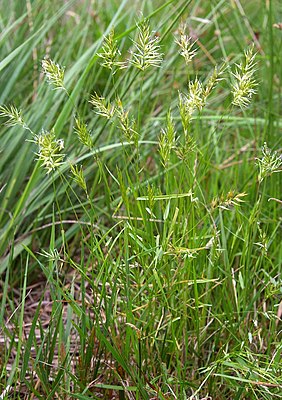Awn stench grass
| Awn stench grass | ||||||||||||
|---|---|---|---|---|---|---|---|---|---|---|---|---|

Awn stork ( Anthoxanthum aristatum ) |
||||||||||||
| Systematics | ||||||||||||
|
||||||||||||
| Scientific name | ||||||||||||
| Anthoxanthum aristatum | ||||||||||||
| Boiss. |
The awn grass ( Anthoxanthum aristatum ) is a species of the genus of grass from the sweet grass family .
description
The awn grass is an annual, tufted grass . The stalks are 6 to 40 centimeters long, branched, slender, smooth and bare and form four to five nodes . The leaf sheaths are glabrous, the lower ones are rarely hairy, at the opening one finds a tuft with 1 to 2 millimeter long hairs. The ligule forms a 1.5 to 3 millimeter long, membranous border. The leaf blade becomes 1 to 6 inches long and 1 to 3 rarely to 5 millimeters wide. It is flat-spread, hairless on top or absent-minded and rough on the edges.
The dense and contracted panicle is 1 to 5 centimeters long and 8 to 15 millimeters wide. The broadly lanceolate, 5 to 9 millimeter long spikelets are three-flowered and disintegrate during the ripening period, so that all three flowers fall out of the glumes together . The two lower flowers are sterile, only the top one is fertile. The membranous glumes are very unequal, ovate, pointed or tapering in a short awning tip, keeled, glabrous only rough on the keel. The lower glume is single-nerved and 3 to 4 millimeters long. The upper one is three-nerved and 5 to 9 millimeters long.
The lemmas of the two sterile flowers are elongated, brown, membranous, 3 to 4 millimeters long, rounded or notched and serrated at the upper end. The lower lemma is five-veined with a 4 to 5 millimeter long awn , the upper lemma is four-veined with a 6 to 10 millimeter long, kneeled and twisted awn in the lower part. The palea is absent. The lemma of the fertile floret is five-veined, 1.6 to 2.0 millimeters long, ovate, entire, smooth, shiny and glabrous. The palea is single-nerved, 1.5 to 1.8 millimeters long, ovate and narrowly rounded. Two stamens are formed, 2.5 to 3.5 millimeters long. Flowering time is between May and June, less often in the second generation from August to September. The fruit is about 2 millimeters long.
The number of chromosomes is 2n = 10.
Distribution and location requirements
The natural distribution area of the awning stalk reaches from Africa ( Algeria , Morocco , Tunisia , Azores , Madeira , Canary Islands ) to southwest Europe (France with Corsica , Portugal, Spain with the Balearic Islands ) and southeast Europe (Albania, Bulgaria, the states of the former Yugoslavia and Italy with Sardinia ) to Asia (Turkey). It was naturalized as a neophyte in northern Europe, North America and Australia . In north-west Germany it occurs frequently in places, and can be found as far as Poland and south to Silesia .
The awn grass can be found in sandy grain fields, on roadsides, on fallow land and ruderal sites . It prefers dry, acidic sandy soils with low levels of humus, low in bases and nitrogen. It is a character species of the Sclerantho-Arnoseridetum minimae from the sub-association Arnoseridenion.
Systematics and taxonomy
The genus Anthoxanthum is assigned to the tribe Aveneae in the subfamily Pooideae . Synonyms for Anthoxanthum aristatum Boiss. are Anthoxanthum puelii Lecoq & Lamotte or Anthoxanthum ovatum subsp. aristatum (Boiss.) Litard.
proof
literature
- HJ Conert: Parey's book of grasses. Recognize and determine the grasses of Germany . Blackwell Wissenschafts-Verlag, Berlin, Vienna 2000, ISBN 3-8263-3327-6 .
Individual evidence
- ↑ a b Conert: Pareys Gräserbuch , p. 96
- ↑ a b c Entry in the Germplasm Resources Information Network (accessed December 19, 2008)
- ↑ Description from USDA Natural Resources Conservation Service (accessed on December 19, 2008)
- ^ Erich Oberdorfer : Plant-sociological excursion flora for Germany and neighboring areas . With the collaboration of Angelika Schwabe and Theo Müller. 8th, heavily revised and expanded edition. Eugen Ulmer, Stuttgart (Hohenheim) 2001, ISBN 3-8001-3131-5 , pp. 263 .
- ↑ Rafaël Govaerts (Ed.): Anthoxanthum aristatum. In: World Checklist of Selected Plant Families (WCSP) - The Board of Trustees of the Royal Botanic Gardens, Kew . Retrieved November 1, 2016.
Web links
- Awn stench grass. In: FloraWeb.de.
- Awn stench grass . In: BiolFlor, the database of biological-ecological characteristics of the flora of Germany.
- Profile and distribution map for Bavaria . In: Botanical Information Hub of Bavaria .
- Thomas Meyer: Data sheet with identification key and photos at Flora-de: Flora von Deutschland (old name of the website: Flowers in Swabia )
